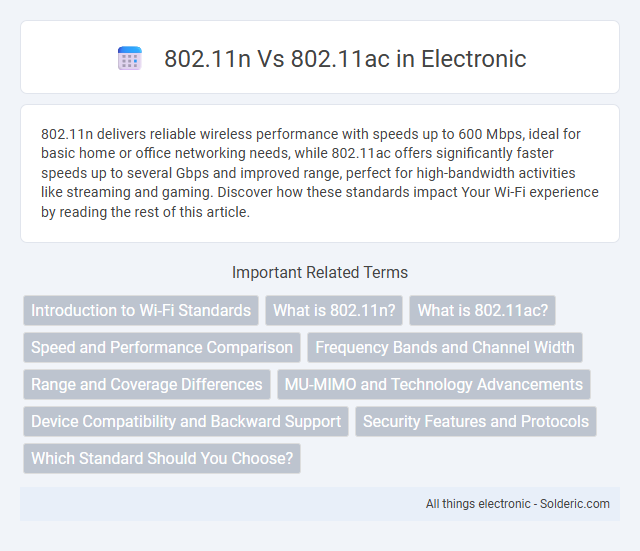802.11n delivers reliable wireless performance with speeds up to 600 Mbps, ideal for basic home or office networking needs, while 802.11ac offers significantly faster speeds up to several Gbps and improved range, perfect for high-bandwidth activities like streaming and gaming. Discover how these standards impact Your Wi-Fi experience by reading the rest of this article.
Comparison Table
| Feature | 802.11n | 802.11ac |
|---|---|---|
| Frequency Band | 2.4 GHz & 5 GHz | 5 GHz only |
| Maximum Data Rate | 600 Mbps | 1.3 Gbps to 6.9 Gbps |
| Channel Width | 20 MHz, 40 MHz | 20 MHz, 40 MHz, 80 MHz, 160 MHz |
| MIMO Streams | Up to 4 | Up to 8 |
| Modulation | OFDM, up to 64-QAM | OFDM, up to 256-QAM |
| Beamforming | Optional | Standardized and improved |
| Backward Compatibility | Compatible with 802.11a/b/g | Compatible with 802.11a/n |
| Latency | Higher latency | Lower latency with MU-MIMO |
| Technology Generation | Wireless N (4th gen Wi-Fi) | Wireless AC (5th gen Wi-Fi) |
Introduction to Wi-Fi Standards
802.11n and 802.11ac are prominent Wi-Fi standards that define wireless networking protocols, with 802.11n operating primarily on 2.4 GHz and 5 GHz bands, supporting maximum speeds up to 600 Mbps through multiple-input multiple-output (MIMO) technology. In contrast, 802.11ac exclusively utilizes the 5 GHz band, offering enhanced channel width and beamforming capabilities, achieving theoretical speeds of several gigabits per second. These standards impact wireless network performance, compatibility, and device interoperability in both residential and enterprise environments.
What is 802.11n?
802.11n is a wireless networking standard introduced in 2009 that significantly improved Wi-Fi speed and range compared to its predecessors, operating on both 2.4 GHz and 5 GHz frequency bands. It supports Multiple Input Multiple Output (MIMO) technology, allowing multiple antennas to transmit and receive data simultaneously, boosting maximum data rates up to 600 Mbps. If your device uses 802.11n, you benefit from enhanced reliability and better network performance in environments with signal interference.
What is 802.11ac?
802.11ac is a wireless networking standard that operates on the 5 GHz band, offering improved speed, range, and capacity compared to 802.11n. It supports wider channels up to 160 MHz, higher modulation schemes like 256-QAM, and multiple-input multiple-output (MIMO) technology, enabling gigabit-level throughput. This standard enhances network performance for bandwidth-intensive applications such as HD video streaming and online gaming.
Speed and Performance Comparison
802.11ac delivers significantly faster speeds compared to 802.11n, reaching up to 1.3 Gbps versus 450 Mbps on 802.11n by utilizing wider channels, more spatial streams, and higher modulation schemes. Performance improvements in 802.11ac include better multi-user MIMO support, which enhances network efficiency and throughput in dense environments. Your wireless experience benefits from these advancements, especially when streaming high-definition content or gaming online.
Frequency Bands and Channel Width
802.11n operates on both 2.4 GHz and 5 GHz frequency bands with channel widths of 20 MHz or 40 MHz, allowing moderate speed and improved range. In contrast, 802.11ac exclusively uses the 5 GHz band and supports wider channel widths up to 160 MHz, enabling significantly higher data throughput and reduced interference. The broader channel width and higher frequency of 802.11ac deliver enhanced performance, particularly in dense wireless environments.
Range and Coverage Differences
802.11n operates on 2.4 GHz and 5 GHz bands, offering maximum ranges of approximately 70 meters indoors and 250 meters outdoors, while 802.11ac is exclusively 5 GHz, providing shorter indoor range around 35 meters but improved throughput and reduced interference. The 802.11n's support for 2.4 GHz frequencies allows better wall penetration and wider coverage, making it suitable for larger areas with obstacles. In contrast, 802.11ac enhances performance with beamforming and higher channel widths but requires closer proximity to the access point for optimal coverage.
MU-MIMO and Technology Advancements
802.11ac introduces Multi-User Multiple Input Multiple Output (MU-MIMO) technology, enabling simultaneous data transmission to multiple devices, significantly improving network efficiency compared to 802.11n, which lacks MU-MIMO support. The advancements in 802.11ac also include wider channel bandwidths up to 160 MHz and higher modulation schemes like 256-QAM, which increase throughput and reduce latency. Your network experiences faster speeds and better performance in dense environments with the upgraded features of 802.11ac over 802.11n.
Device Compatibility and Backward Support
802.11ac offers enhanced speeds and improved performance but maintains backward compatibility with 802.11n devices, ensuring seamless integration in mixed Wi-Fi environments. Devices supporting 802.11ac can connect to 802.11n access points and vice versa, though the connection will default to the older standard's limitations. This backward support facilitates gradual network upgrades without sacrificing existing device operability.
Security Features and Protocols
802.11ac supports advanced security protocols like WPA3, offering enhanced encryption and protection compared to the WPA2 protocol primarily used in 802.11n. Both standards implement robust security features such as AES encryption, but 802.11ac's integration of newer authentication methods strengthens network defense against modern cyber threats. Your wireless network benefits from improved security resilience by adopting 802.11ac devices that comply with the latest security protocols and standards.
Which Standard Should You Choose?
Choosing between 802.11n and 802.11ac depends on your network needs and device compatibility. The 802.11ac standard offers faster speeds up to 3.5 Gbps, improved range, and better performance in crowded environments compared to 802.11n, which maxes out at 600 Mbps. For future-proofing and high-bandwidth activities like 4K streaming or gaming, 802.11ac is the better choice, while 802.11n remains suitable for basic internet use and older devices.
802.11n vs 802.11ac Infographic

 solderic.com
solderic.com